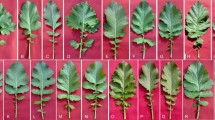Abstract
The successful transference of a hairiness gene, H6 from the wild diploid G. raimondii to G. hirsutum race punctatum has been described. Its usefulness as hairiness gene for jassid resistance is considered to be less important than its value as a marker of a D5 genome chromosome segment introduced into the cultivated tetraploid cottons. New commercially useful variability may be obtained from the introduced segment.
The presence in the D genome of a hairiness gene similar in its effects as H1 of the A genome suggests the possibility that these are homoeologous genes.
Similar content being viewed by others
References
EndrizziJ. E. (1963). Genetic analysis of six primary monosomes and one tertiary monosome in Gossypium hirsutum. Genetics 48, 1625–1633.
GerstelD. U. (1953). Chromosomal translocations in interspecific hybrids of the genus Gossypium. Evolution 7, 234–244.
GerstelD. U. and PhillipsL. L. (1958). Segregation of synthetic amphiploids in Gossypium and Nicotiana. Cold Spring Harbor Symposia on Quantitative Biology 23, 225–237.
KnightR. L. (1952). The genetics of jassid resistance in cotton. I. The genes H1 and H2. J. Genet. 51, 47–66.
KnightR. L. (1954). The genetics of jassid resistance in cotton. IV. Transference of hairiness from Gossypium herbaceum to G. barbadense. J. Genet. 52. 199–207.
KnightR. L. (1955). The genetics of jassid resistance in cotton. V. Transference of hairiness from Gossypium arboreum to G. barbadense. J. Genet. 53, 150–153.
KnightR. L. and SaddJ. (1953). The genetics of jassid resistance in cotton. II. Pubescent T611. J. Genet. 51, 582–585.
KnightR. L. and SaddJ. (1954). The genetics of jassid resistance in cotton. III. The Kapas Purao, Kawanda punctatum and Philippines Ferguson group. J. Genet. 52, 186–198.
MeyerJ. R. (1957). Origin and inheritance of D2 smoothness in Upland cotton. J. Hered. 48, 249–250.
RhyneC. L. (1960). Linkage studies in Gossypium. II. —Altered recombination values in a linkage group of allotetraploid G. hirsutum as a result of transfered diploid species genes. Genetics 45, 673–681.
SaundersJ. H. (1963). The mechanism of hairiness in Gossypium 2. Gossypium barbadense — the inheritance of stem hair. Emp. Cott. Gr. Rev. 40, 104–116.
SaundersJ. H. (1964). Genetics of hairiness transfered from Gossypium anomalum to G. barbadense. Emp. Cott. Gr. Rev. 41, 16–22.
SaundersJ. H. (1965a). The mechanism of hairiness in Gossypium 3. Gossypium barbadense the inheritance of upper leaf lamina hair. Emp. Cott. Gr. Rev. 42, 15–25.
SaundersJ. H. (1965b). The mechanism of hairiness in Gossypium 4. The inheritance of plant hair length. Emp. Cott. Gr. Rev. 42, 26–32.
SilowR. A. (1941). The comparative genetics of Gossypium anomalum and the cultivated Asiatic cottons. J. Genet. 42, 259–358.
SimpsonD. M. (1947). “Fuzzy leaf” in cotton and its association with short lint. J. Hered. 38, 153–156.
Author information
Authors and Affiliations
Additional information
Empire Cotton Growing Corporation
Rights and permissions
About this article
Cite this article
Saunders, J.H. Genetics of hairiness transferred from gossypium raimondii to G. hirsutum. Euphytica 14, 276–282 (1965). https://doi.org/10.1007/BF00149511
Received:
Issue Date:
DOI: https://doi.org/10.1007/BF00149511




